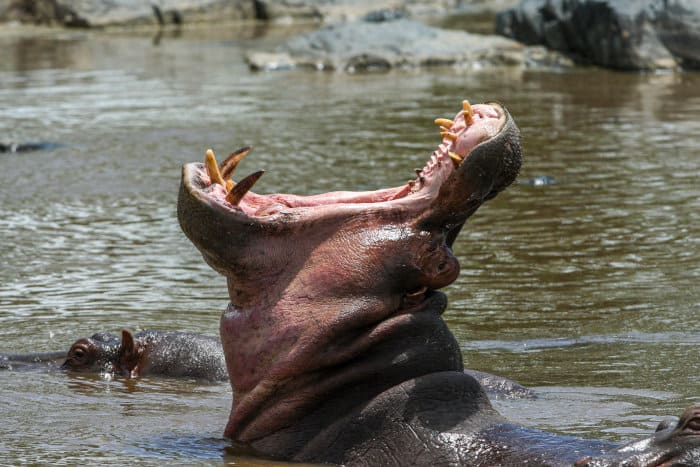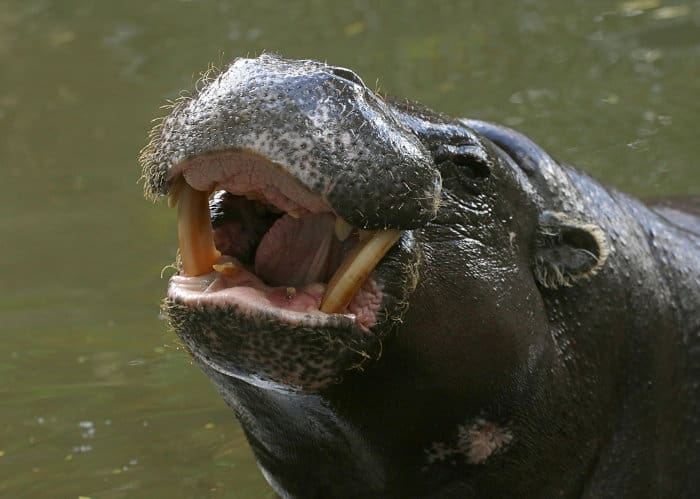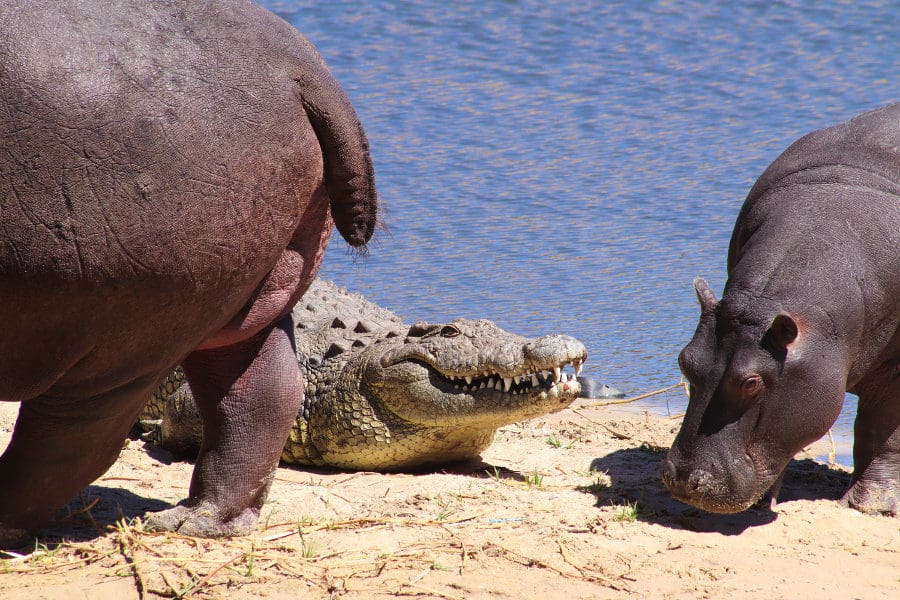Hippo teeth are just the cherry on top when it comes to Africa’s meanest mammal.
Big, fast, and bad-tempered, this is one animal you don’t want to mess with. That’s before it’s even opened its mouth!
Hippos may be vegetarian, but when they yawn, it’s easy to forget that. The ‘river horse’ has teeth to rival any African predator, and it’s not afraid to use them.
Yet, those teeth also pique the interest of poachers, leaving these amazing animals vulnerable to population decline.
Why are hippo teeth so weird? What are they made of? And how do they clean them?
Find out everything you need to know about hippo teeth below.
How Many Teeth Do Hippos Have?
Adult common hippos typically have 36 teeth. If you can count them all, it probably means you’re too close!
The largest, and most obvious, are the canines and incisors. These grow continuously throughout the hippo’s life.
Hippos have four canine teeth and eight incisors. The lower incisors jut forwards, while the curved lower canines are the longest and most tusk-like of the teeth.
Further back in the mouth are the premolars and molars, or ‘cheek teeth.’ Hippos use these for chewing food.
Some adults retain their milk teeth for several years, meaning they might have as many as 40 teeth at once.
Hippo diet – mostly herbivorous

Hippo teeth get a lot of use. These massive mammals spend most of the day cooling off in the water, then emerge at night to gorge on grass.
They pull up vegetation with their lips before grinding it down with their flat molars. Adults can eat 40 kg of grass per day before returning to the water.
Very rarely, hippos scavenge meat or even kill and eat other animals. Their stomachs aren’t suited for meat-eating, though.
A hippo is considered a pseudoruminant, although it doesn’t chew cud. It has a three-chambered stomach, compared to four chambers for true ruminants.
How Big Are Hippo Teeth?
Cartoon hippos are often depicted as cute and cuddly, with short stumps for teeth. This might be because captive animals have their teeth filed down for safety. In the wild, hippo teeth get a lot longer.
Hippos’ incisors grow up to 40 cm long and the lower canines can reach an impressive 50 cm. Male hippos, or bulls, grow larger tusks than females, known as cows.
Open wide

As well as their curved canines, hippos pack a powerful bite thanks to strong jaw muscles.
Hippo jaws are designed to hinge open almost 180 degrees and can clamp down with incredible force. Special folding in the jaw muscles allows such wide ‘yawns’ without tearing any tissue.
One study found that a hippo’s bite force was almost three times that of a lion. No wonder most predators leave them alone.
Why Do Hippos Have Big Teeth?

Those colossal canines seem more suited to a predator, and hippos don’t use them for grinding up grass and other vegetation.
So, why do hippos have such big teeth?
The answer is for both defence and attack.
Hippos are very territorial creatures and use their tusks either for fending off predators or fighting rivals. The upper and lower canines rub against each other whenever a hippo closes its mouth, sharpening its tusks into wicked weapons.
Bull hippos often fight for mating rights, which is one reason they grow longer tusks than cows.
Bulls are often covered in scars from previous wars, with their thick skin protecting them from their opponents’ attacks.
Yet a well-placed blow can prove fatal – dominant males chase off rivals and deliver devastating bites that can break their opponent’s spine.
It’s not just fellow bulls who need to watch out. Testosterone-fuelled males sometimes target hippo calves. And, especially when water levels drop, conflict with crocodiles sometimes ends in violence.
Despite the reptile’s fearsome reputation, crocs usually come off second-best against a hippo.
Too much trouble

With their large size and thick skin, adult hippos aren’t usually on the menu of any African predators. Throw in their giant teeth, and even the hungriest carnivores are normally wise enough to seek easier prey.
Some lions have learned to hunt hippos, but it takes a lot of big cats to bring one down. If the lions make a mistake, it could easily be them being killed.
Baby hippos are more vulnerable, but it would be a brave predator to risk the parents’ revenge.
Hippos and humans
It’s no surprise that hippos are also dangerous to people. Teeth that can chomp a croc in half would make short work of a human. Unfortunately, territorial hippos are some of Africa’s most dangerous animals. They kill around 500 people a year.
Another reason to treat these mammals with a great deal of respect.
Pygmy Hippo Teeth

There’s not just one hippo species boasting an impressive set of teeth. The often-forgotten pygmy hippopotamus is the common hippo’s rarer relative. They look like miniature copies of the common hippo, but there are several differences.
Pygmy hippo teeth may be smaller, yet they’re just as formidable. They, too, have long, curved lower canine tusks and molars to grind vegetation. Pygmy hippos only have one pair of incisors, though.
Pygmy hippos live in forests and swamps of West Africa and are less aquatic than their larger cousins. They also have a more varied diet. They eat less grass, but more ferns, plants, and fruits.
This shy species would prefer to avoid conflict, but can defend itself with its sharp canines if needed. Opening its powerful jaws and showing off those tusks would send most predators packing!
What Are Hippo Teeth Made Of?

Hippo teeth are like most mammals’ teeth, with several layers of tissue of varying hardness.
Their canines and incisors are known as ivory, just like elephant tusks. They’re made mostly of dentin, with an outer layer of enamel.
Presidential dentures
Surprisingly, it’s not just hippos that had hippo teeth in their mouths. Hippo ivory was often used in dentures during the 18th century.
One famous US president even had several pairs. The myth is that George Washington had wooden teeth – when he took office, his dentures were actually made of hippo ivory, brass, and gold.
Poaching problem

Hippos’ huge teeth deter most predators, though they attract unwanted attention from some humans.
Elephant ivory is an infamous target for poachers, but hippo ivory is also a sought-after material. Humans may not use it for dentures anymore, yet there is still a market for hippos’ teeth.
These teeth are traded both legally and illegally, with most exported to Asian countries such as Hong Kong.
Here, the ivory is carved into sculptures and other ornaments. Differences between reported and unreported trade figures are concerning, suggesting a lot of ivory is illegally obtained.
With tighter regulations protecting elephants from poaching, hippos may suffer as people seek an alternative source of ivory.
The common hippopotamus is currently listed as ‘vulnerable’ by the IUCN. Its situation is not as dire as some African mammals’, but ivory poaching is a worrying threat to this iconic animal.
Pygmy hippos are also poached for their meat and ivory. There are just a couple of thousand individuals in the wild, and it is classified as an endangered species.
How Do Hippo Teeth Get Cleaned?

Hippos may produce their own sunscreen, but unfortunately, they don’t make their own toothpaste. Hooves aren’t the best tools to clean with, either.
Captive hippos sometimes get a hand from a helpful zookeeper and a giant toothbrush. Obviously, wild ones don’t have that luxury. (Volunteer dentists aren’t lining up, either!)
Luckily, nature provides its own tooth cleaners.
Whenever a hippo feels like a dental check-up, it enlists the help of fish such as barbels. These fish nibble off dead skin and parasites, on the hippo’s skin and even in its mouth. The fish get a meal, and the hippo gets a free service.
On land, hippos sometimes get a different kind of ‘dental bill’. Oxpeckers, or tickbirds, are well-known for their habit of eating parasites from large herbivores’ skin.
They mostly feed on the backs of animals such as hippos, but can find a meal inside the ears, nostrils, or even mouths of their hosts.
The birds also pick at existing wounds, so hippos with gum issues might not appreciate the oxpecker’s assistance.
Admire Hippo Teeth (From Afar)

If you want to see hippo teeth – attached to the animal – then there are many places to observe these magnificent mammals.
Common hippos live in rivers and lakes throughout much of sub-Saharan Africa and are frequently seen on safari.
Like most African animals, they’re best admired from a safe distance – unless you want a first-hand experience of what hippo teeth can do.
Pygmy hippos are more elusive and less widespread, but there are opportunities for the more adventurous.
Why not try a national park in Liberia or Côte d’Ivoire?



